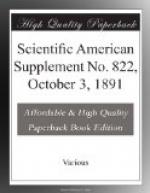Having, as previously stated, applied tourniquets to the central portion of the lower limbs, the ether cap was placed over the mouth and nose of the patient, and in an incredibly short time he was unconscious, and the surgeons were able to go on with the operation.
The late Dr. Cornelius R. Agnew and many other members of the staff of the hospital were present, and gave emphatic expressions of approval.
Dr. F.W. Ring, assistant surgeon to the Manhattan Eye and Ear Hospital, declared that both the amount of ether and the time consumed in its administration were infinitesimal when compared with what had been expended in previous efforts at inducing anaesthesia in the usual way. The facts brought out on this occasion with regard to the administration of ether have since been repeatedly verified by different observers; so that at the present day their validity cannot be questioned. I will merely add, however, that I have long known that the dosage of phenacetin, antipyrine, morphine, chloralamid, chloral, the bromides, and many other remedies might be reduced by resort to the same procedure; all of which is merely equivalent to stating that their pharmaco-dynamic energy may be increased in this way. And this brings us to the second fact, which requires no special elaboration, and may be stated thus:
Second Fact.—The duration of the effect of a remedy upon the cerebro-spinal axis is in the inverse ratio of its volatility; and this is equally true whether the remedy be given with or without the precautions previously detailed. For example, the anaesthetic effects of ether disappear shortly after removal of the inhaler, whether we apply tourniquets to the extremities or not; but, on the other hand, the analgesic influence of antipyrin, phenacetin, morphine, and other like remedies lasts very much longer, and their dose may be reduced, or—what is the same thing—their pharmaco-dynamic potency may be enhanced by the sequestration of the blood contained within the extremities. So far as I know, I was the first to announce this fact. In so far as a simple expression of the above truth is concerned, we may employ the following formula:
Let a represent the normal blood-mass contained in the entire body, d the amount of blood sequestrated by the ligatures, b the amount of the remedy, c the volatility of the remedy, and x the pharmaco-dynamic potency of which we are in search; we shall then have
b x = ----------- (a — d’) x c
We now arrive at our third fact, which will require more extensive elaboration.
Third Fact.—The pharmaco-dynamic potency of stimulants, sedatives, analgesics, and probably of all remedies which possess a chemical affinity for nervous matter, is enhanced by exhibiting them (the remedies) in solution or soluble form—hypodermically, by the mouth, or per rectum—while the subject remains in a condensed atmosphere. And, as a corollary, it may be stated that this increase, this enhancement of the potency of the remedy is, within certain limits, in the ratio of the atmospheric condensation.




